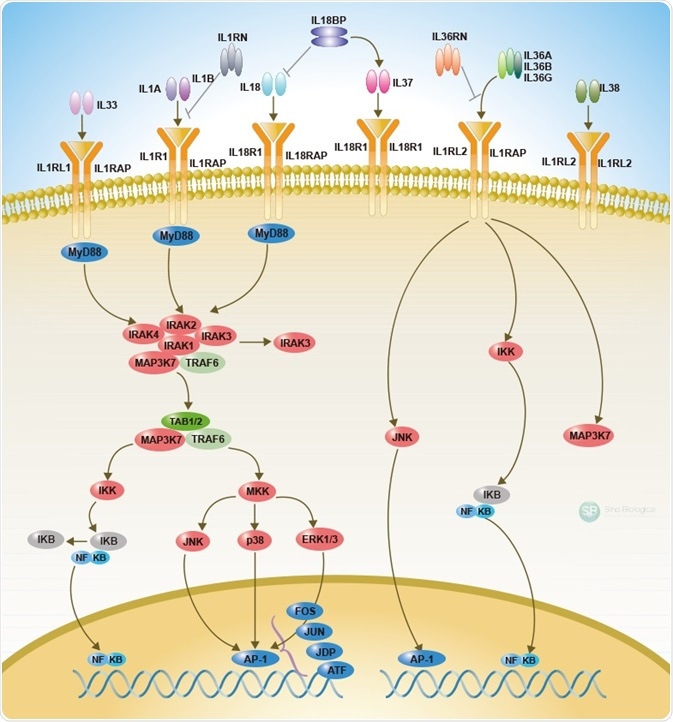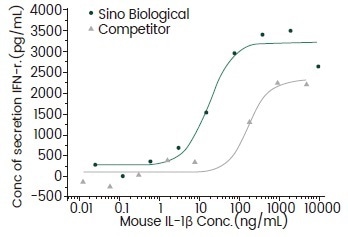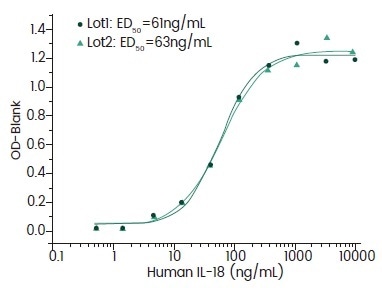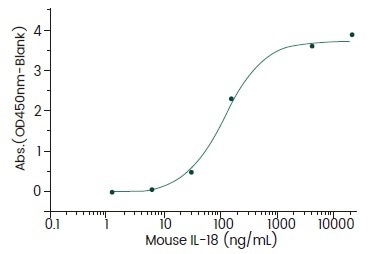Interleukins (ILs), a group of cytokines, are produced by leukocytes and non-immune cells like endothelial, fibroblasts, smooth muscle, epithelial and bone marrow cells.1 ILs mainly act as immunomodulators and are called immunological “secondary messengers.”
Also, they help in cell proliferation, activation, differentiation, migration and adhesion. There are nearly 40 different kinds of ILs. Interleukin-1 (IL-1) cytokines were the ones that were discovered initially and are also the most widely studied among ILs.1,2 IL-1 has an extensive impact on immunology and medicine at large.
The IL-1family of cytokines
IL-1 belongs to the particular class of interleukins that are frequently known for their pro- and anti-inflammatory cytokine members. Right from the first discovery of two members, IL-1α and IL-1β,3 the family of IL-1 has extended to include nine more cytokines, IL-1Ra, IL-18, IL-33, IL-36α, IL-36β, IL-36γ, IL-36Ra, IL-37, and IL-38.4
Amongst these 11 cytokines, seven of them exhibit agonist activity (IL-1α, IL-1β, IL-18, IL-33, IL-36α, IL-36β, IL-36γ), three are receptor antagonists (IL-1Ra, IL-36Ra, IL-38), and one is an anti-inflammatory cytokine (IL-37).4,5
Every IL-1 cytokines trigger intracellular signaling by binding to particular receptors and, at times, co-receptors. There are 10 known kinds of IL-1 receptors that contain cytokine-specific receptors, co-receptors and inhibitory receptors.
Amongst them, six are receptor chains developing four signaling receptor complexes, two are decoy receptors (IL-1R2, IL-18R), and two are negative regulators (SIGIRR, IL-1RAcP)4,5.
The majority of the IL-1 receptors possess a similar structure consisting of three extracellular immunoglobulin (Ig) domains and an intracellular Toll-like/IL-1R (TIR) domain. Below is a list of the IL-1 family of cytokines with particular receptors and co-receptors.
Sino Biological has come up with excellent reagents and products that vary from recombinant antibodies, proteins, ELISA kits and more. Such products could help expedite users’ research on the IL-1 family of cytokines and also other ILs.
List of IL-1 family members and receptors
Source: Sino Biological Inc.
| Type of activity |
Cytokine |
Receptor |
Co-receptor |
| Agonists |
IL-1α
IL-1β
IL-33
IL-18
IL-36α
IL-36β
IL-36γ |
IL-1R1, IL-1R2
ST2
IL-18Rα
IL-1Rrp2
|
IL-1RAcP
IL-18Rβ
IL-1RAcP
|
| Antagonists |
IL-38
IL-36Ra
IL-1Ra |
IL-1R1 |
--
--
-- |
| Anti-inflammatory |
IL-37 |
IL-18Rα |
SIGIRR |
IL-1 signaling and associated diseases
There is a heavy control on protein production, maturation, receptor binding and signaling of the IL-1 family of cytokines.5 For instance, the 271 and 269 amino acid residue precursors of IL-1α and IL-1β are split into mature forms by calpain and caspase-1 triggered in the inflammasome, respectively.6,7
At the same time, IL-1s have a defined specificity while binding to receptors, as listed in the table.6,8 The binding of IL-1s to specific IL-1 receptors results in downstream events and signal transduction, thereby eliciting an inflammation6,7,9 (Figure 1).
 Figure 1. IL-1 Family Signaling Pathways (Reserved by Sino Biological). Image Credit: Sino Biological Inc.
Figure 1. IL-1 Family Signaling Pathways (Reserved by Sino Biological). Image Credit: Sino Biological Inc.
Different pathological conditions result from the loss of homeostasis. IL-1 family members play a role in immune regulation, but their scope extends beyond inflammatory diseases. Multiple pathologies6 have been linked to the IL-1 family of cytokines, including autoimmune diseases,10 cancer progression,11 neurodegeneration,12 cardiovascular diseases,13 and infectious diseases such as COVID-19.14
IL-1 Family cytokines as drug targets and anti-IL-1 therapy
IL-1 family of cytokines is one of the most famous targets in the treatment of multiple pathologies.6, 10-14 Anakinra is a clinically approved recombinant IL-1Ra that helps block the activity of IL-1α and IL-1β.4
It has been utilized to treat psoriatic arthritis, rheumatoid arthritis, ankylosing spondylitis, metastatic colon cancer, macrophage-activating syndrome (MAS) and several other conditions.
Canakinumab and Gevokizumab are known as monoclonal antibodies against IL-1β that are utilized in the treatment of multiple conditions like auto-inflammatory diseases, lung cancer and adult-onset Still’s disease (AOSD).15
MABp1 is known as an anti-IL-1α therapeutic antibody that has been utilized in the treatment of advanced colorectal cancer. Rilonacept is a dimeric fusion protein comprising portions of the IL-1R1 and the IL-1RAcP linked to the Fc domain of IgG1.
It is utilized to treat recurrent chronic inflammatory disorders16 and Pericarditis. Anti-IL-1 therapy has even become an attractive modality for the treatment of several diseases.
Featured recombinant IL-1 family proteins
Recombinant IL-1β protein
Sino Biological has come up with bioactive recombinant IL-1β cytokines from several species, like mouse, human, rabbit, rhesus, rat, canine and feline.

Image Credit: Sino Biological Inc.
In comparison to the competing product, Sino Biological’s IL-1β protein illustrates greater bioactivity as shown below.

Induce Interferon Gamma Secretion. Cat#: 50101-MNAE. Image Credit: Sino Biological Inc.
Recombinant IL-18 proteins
Sino Biological has come up with a high bioactivity IL-18 protein from several species. The activity of such proteins has been confirmed in IFN-γ induction experiments and binding assays against the IL-18 receptors.
H 10119-HNCE (Mature Form)

Induce IFN Gamma Secretion. Image Credit: Sino Biological Inc.
M 50073-MNCE (Mature Form)

Bind with IL-18Rα (Cat#: 50094-M38H). Image Credit: Sino Biological Inc.
References
- Brocker, C., Thompson, D., Matsumoto, A., Nebert, D. W., & Vasiliou, V. (2010). Evolutionary divergence and functions of the human interleukin (IL) gene family. Human genomics, 5(1), 30–55. https://doi.org/10.1186/1479-7364-5-1-30
- Ferreira, V. L., Borba, H. H. , de F. Bonetti, A., P. Leonart, L., & Pontarolo, R. (2018). Cytokines and Interferons: Types and Functions. In (Ed.), Autoantibodies and Cytokines. IntechOpen. https://doi.org/10.5772/intechopen.74550
- Lachman, L. B., Hacker, M. P., & Handschumacher, R. E. (1977). Partial purification of human lymphocyte-activating factor (LAF) by ultrafiltration and electrophoretic techniques. Journal of immunology (Baltimore, Md.: 1950), 119(6), 2019–2023.
- Garlanda, C., Dinarello, C. A., & Mantovani, A. (2013). The interleukin-1 family: back to the future. Immunity, 39(6), 1003–1018. https://doi.org/10.1016/j.immuni.2013.11.010.
- Palomo, J., Dietrich, D., Martin, P., Palmer, G., & Gabay, C. (2015). The interleukin (IL)-1 cytokine family--Balance between agonists and antagonists in inflammatory diseases. Cytokine, 76(1), 25–37. https://doi.org/10.1016/j.cyto.2015.06.017.
- Kaneko, N., Kurata, M., Yamamoto, T., Morikawa, S., & Masumoto, J. (2019). The role of interleukin-1 in general pathology. Inflammation and regeneration, 39, 12. https://doi.org/10.1186/s41232-019-0101-5.
- Dinarello C. A. (2010). IL-1: discoveries, controversies and future directions. European journal of immunology, 40(3), 599–606. https://doi.org/10.1002/eji.201040319
- Migliorini, P., Italiani, P., Pratesi, F., Puxeddu, I., & Boraschi, D. (2020). The IL-1 family cytokines and receptors in autoimmune diseases. Autoimmunity reviews, 19(9), 102617. https://doi.org/10.1016/j.autrev.2020.102617
- Dinarello CA. Overview of the IL-1 family in innate inflammation and acquired immunity. Immunol Reviews. 2018 Jan;281(1):8-27. doi: 10.1111/imr.12621. PMID: 29247995; PMCID: PMC5756628.
- Dinarello C. A. (2011). Interleukin-1 in the pathogenesis and treatment of inflammatory diseases. Blood, 117(14), 3720–3732. https://doi.org/10.1182/blood-2010-07-273417
- Zhang, W., Borcherding, N., & Kolb, R. (2020). IL-1 Signaling in Tumor Microenvironment. Advances in experimental medicine and biology, 1240, 1–23. https://doi.org/10.1007/978-3-030-38315-2_1
- Voet, S., Srinivasan, S., Lamkanfi, M., & van Loo, G. (2019). Inflammasomes in neuroinflammatory and neurodegenerative diseases. EMBO molecular medicine, 11(6), e10248. https://doi.org/10.15252/emmm.201810248
- Abbate, A., Toldo, S., Marchetti, C., Kron, J., Van Tassell, B. W., & Dinarello, C. A. (2020). Interleukin-1 and the Inflammasome as Therapeutic Targets in Cardiovascular Disease. Circulation research, 126(9), 1260–1280.
- Mardi, A., Meidaninikjeh, S., Nikfarjam, S., Majidi Zolbanin, N., & Jafari, R. (2021). Interleukin-1 in COVID-19 Infection: Immunopathogenesis and Possible Therapeutic Perspective. Viral immunology, 34(10), 679–688. https://doi.org/10.1089/vim.2021.0071
- Blech, M., Peter, D., Fischer, P., Bauer, M. M., Hafner, M., Zeeb, M., & Nar, H. (2013). One target-two different binding modes: structural insights into gevokizumab and canakinumab interactions to interleukin-1β. Journal of molecular biology, 425(1), 94–111. https://doi.org/10.1016/j.jmb.2012.09.021
- Stahl, N., Radin, A., & Mellis, S. (2009). Rilonacept--CAPS and beyond. Annals of the New York Academy of Sciences, 1182, 124–134. https://doi.org/10.1111/j.1749-6632.2009.05074.x
About Sino Biological Inc.

Sino Biological is an international reagent supplier and service provider. The company specializes in recombinant protein production and antibody development. All of Sino Biological's products are independently developed and produced, including recombinant proteins, antibodies and cDNA clones. Sino Biological is the researchers' one-stop technical services shop for the advanced technology platforms they need to make advancements. In addition, Sino Biological offers pharmaceutical companies and biotechnology firms pre-clinical production technology services for hundreds of monoclonal antibody drug candidates.
Sino Biological's core business
Sino Biological is committed to providing high-quality recombinant protein and antibody reagents and to being a one-stop technical services shop for life science researchers around the world. All of our products are independently developed and produced. In addition, we offer pharmaceutical companies and biotechnology firms pre-clinical production technology services for hundreds of monoclonal antibody drug candidates. Our product quality control indicators meet rigorous requirements for clinical use samples. It takes only a few weeks for us to produce 1 to 30 grams of purified monoclonal antibody from gene sequencing.
Sponsored Content Policy: News-Medical.net publishes articles and related content that may be derived from sources where we have existing commercial relationships, provided such content adds value to the core editorial ethos of News-Medical.Net which is to educate and inform site visitors interested in medical research, science, medical devices and treatments.